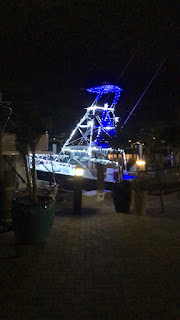Punta Gorda, FL 12/5 - 12/7
My wife and I had use it or lose it airline credit, so we took a short trip to west Florida to visit family prior to the holidays. Our first stop took us to Punta Gorda. The small city is the county seat of Charlotte County and rests along Charlotte Harbor. The area was hit hard by Hurricane Ian back in September. Homes and property still under repair and piles of debris yet to be picked up are lingering signs of the hurricane’s impact.
We spent two days with my uncle, so all my birding would be incidental. One can build a modest bird list by incidental birding in Florida just about any time of the year. I was able to check off many of the typical Florida birds in the neighborhood where we stayed. Osprey, pelicans, palm warblers and the whole family of herons, egrets and ibis that were in New Jersey not too long ago were plentiful in Punta Gorda. Anhingas, rare in New Jersey, are a common sight throughout Florida. Red-shouldered hawks are much more common in the south also. Eurasian collared-doves, whose northward expansion seems to have stalled, were easy to spot on utility wires.
One of the mornings while I was exploring the neighborhood, I heard a bird call that was new to me. After a few minutes of searching the treetops and utility poles, I located the source - a pair of loggerhead shrikes. Pretty much a common bird in Florida, loggerhead shrikes are a bird records committee reviewable species in New Jersey. One hasn't been seen in the Garden State in over eight years now. The best bird I saw was one I almost missed. While driving down the local highway, a large raptor flew over the car. My brief glimpse of it ruled out an osprey and bald eagle. Other possibilities quickly ran through my head until crested caracara came to mind. I was going to shrug it off, but luckily in Florida U-turns are permitted along highway medians. In most of New Jersey such turns are not allowed. An inconvenience, but probably best for our sakes. (When I was young, the inspection stickers on cars in the Garden State used to have "The Safest State" emblazoned on them, not anymore.) Anyway, the traffic was light, and I made the U-turn at the first median opening. Up ahead I spotted the bird on top of a tree along the roadside, it was indeed a crested caracara. I pulled over and took a couple photos. Nearby was the carcass of some animal, which is probably what lured in this large falcon. I had seen caracaras in Costa Rica, but this was my first for the United States.
My uncle's house sits along a lagoon, or canal. Actually, all the streets in his neighborhood have water on either side. Everyone has a boat; some have two boats. Tarpon, snook, catfish, mangrove snappers and sheepshead can be caught fishing from his bulkhead. He took my wife and I out on his boat. It was his first venture out since the hurricane, so he was a little wary about submerged debris. We fished a bit in the lagoons hoping to catch a crevalle jack or a redfish. The weather was beautiful, but the fishing was slow. Eventually we made our way out to the harbor. There we caught some small sea trout and ladyfish, and a bonnethead shark swam past.
The best interaction was back in the lagoon. A manatee briefly popped up near the boat. Manatees are common there, but as for my wife and I, we could count our combined manatee encounters on one hand. This encounter was special. For about a half hour or more, from when we first spotted the herbivore until we moved out to the harbor it followed the boat wherever we slow trolled, coming closer every time it surfaced. I don't know if it was more curious with us or us with it. It came up right alongside us, even rubbing its head and back against the boat. The creature bore scars on its back, suggesting that it had come too close to another boat and its propeller once before. It seemed healthy, nonetheless. It was an unexpected yet pleasant highlight of our short vacation.













Comments
Post a Comment